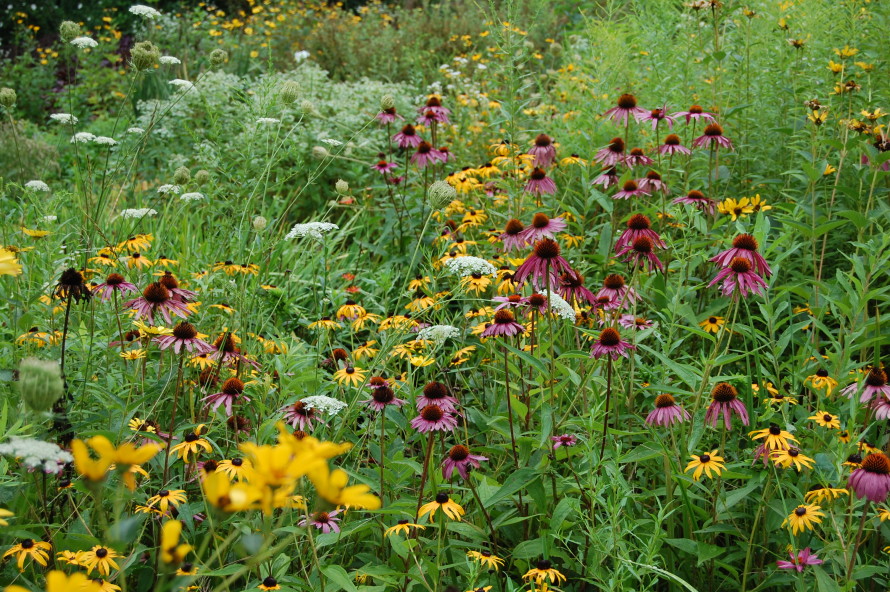The original cottage gardens were tiny gardens attached to worker cottages. They contained a mix of herbs and vegetables with a few flowers to fill in spaces and add a decorative touch. Over the centuries, these gardens evolved to be filled with flowers only. Vegetables and herbs have split off into their own gardens. The term “cottage garden” is most often used now to describe a style of gardening. An informal style that is supposed to look “natural”. Many herbs have beautiful flowers and are still used in cottage style gardens for their ornamental value. Many of them are considered “classic” cottage garden flowers.
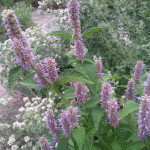
Anise Hyssop
Anise Hyssop – Agastache foeniculum a member of the mint family, but not as invasive, anise hyssop is native to the North American prairies where it can reach a height of four feet. It is perennial and hardy through zone 4. The flowers attract bees and butterflies. Allow the flowers to go to seed and watch the goldfinches flock to your garden to feast on the seeds. Anise hyssop seeds can be started indoors or direct sown in your garden. Do not cover the seed. It needs light to germinate. Once the plants are established, do not over-water. Anise hyssop prefers dry conditions. It likes sun but can tolerate a little shade.
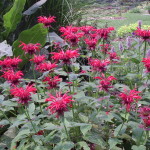
Bee Balm
Bee Balm – a native of eastern North America and a magnet for bees, butterflies and hummingbirds, it comes in four varieties. Monarda didyma, with its familiar red flower, Monarda fistulosa, the so-called “wild bergamot” sporting lavender flowers and Monarda citriodora andMonarda pectinada, with fewer, lavender to lilac flowers, both known as “lemon mint”. Bee balm is a perennial hardy through zone 4. A member of the mint family, it spreads but is not invasive. Depending on the variety, it grows between two and four feet tall, preferring full sun but can tolerate some shade. Bee balm is easily grown from seed. Direct sow it in your garden, pressing the seed firmly into the soil but don’t cover it. It needs light to germinate. Keep it well watered but not wet. Clumps should be divided every three years as the centers die out.

Catmint
Catmint – Nepeta x faassenii Catmint is not a mint, although it is in the mint family. It is related to catnip and contains the same cat attracting chemical (nepetalactone) as catnip, but in lower concentrations. Cats find it just as appealing as catnip. Catmint is a herbaceous perennial hardy in zones 3 through 8. It is usually grown as an ornamental plant thanks to its fragrant foliage and sprays of blue flowers which appear in the spring. Depending on the variety, catmint can grow as tall as 3 to 4 feet. It is drought tolerant. Like mints, it prefers full sun but will tolerate partial shade. Most catmints that are available for sale produce sterile seed, so propagation is done by division. Plants should be divided every 3 to 4 years to keep them healthy.
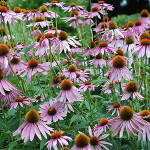
Echinacea
Echinacea – Echinacea purpurea A North American native and a member of the sunflower family, Echinacea is a perennial that is hardy through zone 3. Mature heights vary from 2 to 4 feet. It prefers full sun but will tolerate light shade and is drought tolerant making it a welcome addition to any xeriscape. Echinacea is easy to grow from seed and, in fact, readily self sows. This is another plant that attracts goldfinches when the flowers go to seed. Plant seed outdoors in the fall or if starting indoors, provide them with 4 to 6 weeks of cold stratification. Germination is 10 to 14 days. Mature plants can also be divided.
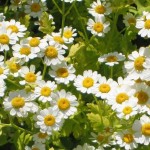
Feverfew
Feverfew – Tanacetum parthenium Feverfew is a perennial that is native to the Eurasian part of the Mediterranean. It spread throughout the entire Mediterranean area as well as Europe. Then European colonists introduced it to North America where it is hardy through zone 5. Feverfew isn’t fussy about soil. It grows best in rich loamy soil but it will tolerate poorer soils. It prefers sun, but doesn’t mind a little shade. Mature plants reach a height of 18 to 24 inches and flower all summer provided you deadhead them (remove dead or dying flowers) regularly. Feverfew can be grown from seeds, cuttings or by division. To grow feverfew from seed, start it indoors six to eight weeks before your last frost date. Sow your seeds on the surface of your soilless mix. Don’t cover them! The seeds need light to germinate. Germination is within 1 to 2 weeks. Harden off your seedlings and plant them eighteen inches apart in your sunny garden after your last frost date.
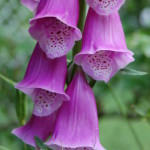
Foxglove
Foxglove – Digitalis spp Foxgloves are native to the woodland edges of Europe and North Africa. They can grow in full sun but prefer semi-shade or shade. The plants prefer rich, well-drained soil. They cannot grow in damp conditions. Foxglove are biennials that are hardy in zones 4 through 8. The first year, a rosette of leaves develops at the base of the plant. The second year, the rosette of leaves grows again and then a stalk with bell shaped flowers appears in late spring or early summer. Depending on the variety, the stalks can be 2 to 5 feet high. Growing foxglove from seed is also very easy. You can direct sow it in your garden in the summer, to germinate in the fall, or in the fall or spring to germinate in the spring. Surface sow the seeds. They need light to germinate. The seeds will germinate in 14 to 21 days at 60⁰F to 65⁰F. Seeds can also be started indoors in the early spring. Again, surface sow them so that they are exposed to the light that they need to germinate. Seedlings can be transplanted into your garden after your last frost.

Lavender Grosso
Lavender – a member of the mint family and native to southern Europe, lavender is a shrubby perennial that comes in seemingly infinite varieties. When purchasing lavender, look at the Latin name. There are three types of lavender commonly offered for sale: Lavandula angustifolia (English lavender), Lavandula stoechas (Spanish lavender, the flowers look like butterflies), and Lavandula dentata (French lavender, the leaves are serrated). Lavender is easy to grow and seemingly indestructible. In some parts of Europe, it’s considered an invasive weed! Don’t waste your money buying seed. The germination rate is miniscule except for an AAS variety called Lady Lavender which is very tiny and not terribly fragrant. Buy a plant and put it in the sunniest, hottest, driest spot in your garden and then forget about it.
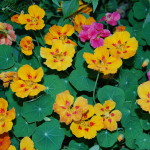
Nasturtiums
Nasturtiums – Tropaeolum majus Native to Central and South America, nasturtiums have become naturalized in parts of the US. It is an annual plant with a trailing habit to 3 1/2 feet. Compact varieties grow to 12 inches. It is annual through zone 4, but perennial in zones 9 – 11. They require full sun and well-drained soil. Both the flowers and leaves are edible with a peppery taste. Nasturtiums will readily reseed themselves in your garden or you can direct sow them after soaking them overnight. Plant the seeds ½ inches deep. They need darkness to germinate. Germination should occur in 7 to 10 days. Do not fertilize or you will get only leaves and no flowers.
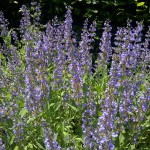
Sage
Sage – Salvia officinalis a non-invasive member of the mint family, sage is native to the Mediterranean but has naturalized throughout much of the world. It is a perennial sub-shrub that is hardy through zone 5. The plants become woody within three to four years and will need to be replaced. Mature plants reach a height of 3 feet. Sage can be grown from seeds or cuttings. Seeds can be started indoors 1 to 2 weeks before your last frost date. Cuttings take longer and should be started 6 to 8 weeks before your last frost date. Plant your sage in a sunny, well-drained location. Sage does not like wet feet. Wait until the second year before harvesting the leaves.

Violets
Violets – Viola odorata Native to Europe and Asia but now naturalized throughout North America and Australia., violets are perennials that are hardy through zone 4. Plants grow to 15 inches and will grow in full sun, but prefer semi-shade or full shade. They prefer rich soil. Seeds can be direct sown in the fall for winter cold stratification or if starting seeds indoors, cold stratify them in your refrigerator for 4 to 6 weeks. After, plant your seeds ¼ inches deep. Germination should occur in 21 – 35 days. Plant your seedlings outdoors after all danger of frost has passed.
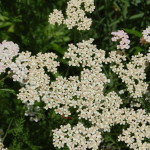
Yarrow
Yarrow – Achillea millefolium Native to the temperate regions of the northern hemisphere, it is hardy through zone 3. It is a member of the Aster family and depending on the variety, it grows from 2 to 4 feet tall. Yarrow needs full sun and dry, well-drained soil. It is drought tolerant and does well in a xeriscape. Yarrow is easy to grow from seed. The seeds need light to germinate, so either surface sow them or barely cover them. They will germinate when the temperature reaches at least 65°F and up to 75°F. Yarrow can also be propagated by division. It’s a good idea to divide your plants every two to three years.

